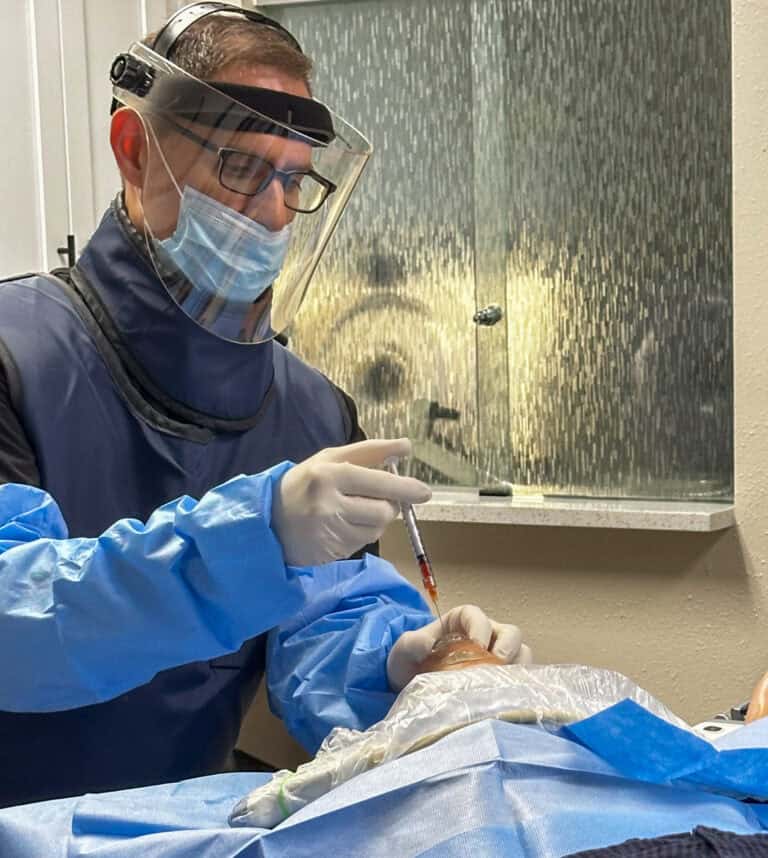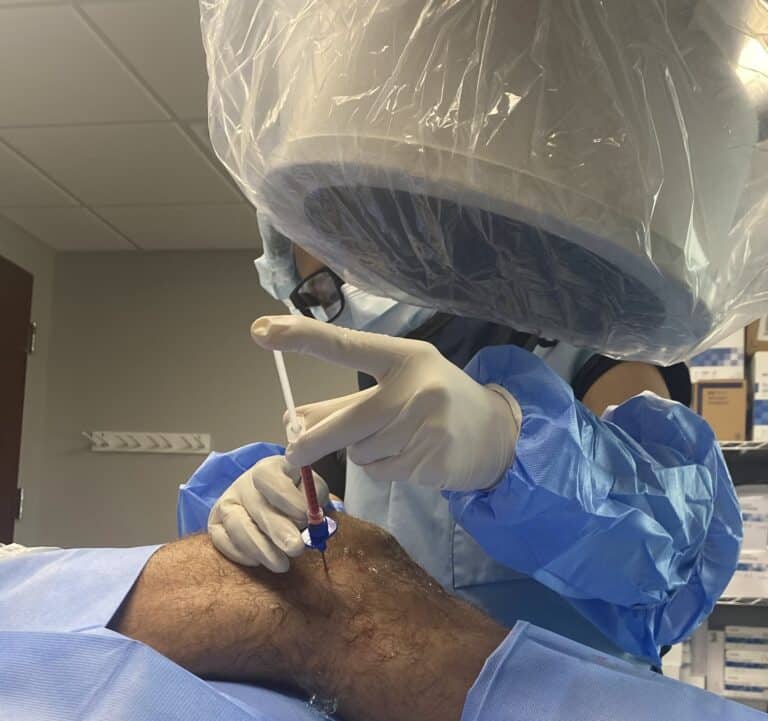The shoulder is a marvel of engineering. It has a wide and versatile range of motion coupled with exceptional strength. When something goes wrong with your shoulder, it hampers your ability to move freely and can cause a great deal of pain and discomfort.
The shoulder is a ball-and-socket joint that has three main bones: the humerus (long arm bone), the clavicle (collarbone), and the scapula (the shoulder blade).
These bones are cushioned by a layer of cartilage. There are two main joints. The acromioclavicular joint is between the highest part of the scapula and the clavicle.
The glenohumeral joint is made up of the top, ball-shaped part of the humerus bone and the outer edge of the scapula. This joint is also known as the shoulder joint.
As I mentioned earlier, the shoulder joint is the most mobile joint in the body. It moves the shoulder forward and backward. It also allows the arm to move in a circular motion and to move up and away from the body.
Shoulders get their range of motion from the rotator cuff.
The rotator cuff is composed of four tendons. Tendons connect muscle to bone. If these tendons are damaged or swollen, it may be painful or difficult to lift your arm over your head.
You can injure your shoulder by performing manual labor, constant repetitive activities, through a traumatic event (falls, etc.), or sports with overhead motions. Certain diseases can bring about pain that travels to the shoulder. These include cervical spine (neck) issues, as well as liver, heart, or gallbladder disease.
People are more likely to have problems with your shoulder as we grow older, especially after age 60. This is because the soft tissues surrounding the shoulder tend to degenerate with age.
In many cases, you can treat shoulder pain at home. However, physical therapy, medications, or surgery may also be necessary.
Here’s what you need to know about shoulder pain, including causes, diagnosis, treatment, and prevention.
What Causes Should Pain?
Several factors and conditions can contribute to shoulder pain. The most prevalent cause is rotator cuff tendinitis.
This is a condition characterized by swollen tendons. Another common cause of shoulder pain is impingement syndrome where the rotator cuff gets caught between the acromion (part of the scapula that covers the ball) and humeral head (the ball portion of the humerus).
Other causes of shoulder pain include:
- Arthritis
- Torn cartilage
- Torn rotator cuff
- Swollen bursa sacs
- Pinched nerve in the neck or shoulder
- Broken shoulder or arm bone
- Frozen shoulder
- Dislocated shoulder
- Heart attack (If your shoulder pain is sudden and not related to an injury, call 911 immediately. It may be a sign of a heart attack).
How Does Shoulder Pain Get Diagnosed?
The longer you wait to treat your shoulder pain, the worse it can get, and the harder it may be to treat. An early diagnosis and intervention is critical. Your doctor will start with a thorough history and physical examination of your neck and upper extremity.
Your doctor may also order imaging tests, such as an MRI scan, a CT scan, or an X-ray to get a better look at the health of your shoulder. If trained adequately, your doctor may be able to administer a highly technical and informative diagnostic ultrasound exam at the time of your consultation.
Is Surgery the Best Option for Treating Shoulder Pain?
Non-surgical interventions are generally preferred. In fact, Harvard Medical School warns that surgery should be the last resort for treating a joint condition like shoulder pain. Like any other arthroscopy shoulder surgery, the lack of effective outcomes of rotator cuff repair is also concerning.
- A great deal of research has shown that for many types of tears, rotator cuff surgery is largely ineffective.
- Even the full-thickness rotator cuff tears have been shown to improve just as well with physical therapy. In other words, surgery improved the rotator cuff tear no better than PT.
- Rotator cuff tear surgery, unfortunately, doesn’t seem to result in less pain, regardless of the severity of the tear.
- Large rotator cuff tears have been shown to not heal correctly—as many as 6 in 10 following surgery.
- At least one study suggests that 1 in 3 rotator cuff tears don’t heal following surgery in the 60 or older age group!
Some minor shoulder pain can be treated at home. Icing the shoulder for 15 to 20 minutes three or four times a day for several days can help reduce pain. Use an ice bag or wrap ice in a towel because putting ice directly on your skin can cause frostbite and burn the skin.
Resting the shoulder for several days before returning to normal activity and avoiding any movements that might cause pain can be helpful. Limit overhead work or activities.
Your doctor may suggest a variety of non-surgical approaches to effectively relieve your shoulder pain:
- Lifestyle modifications including dietary changes, weight loss, and certain exercises guided initially by a physical therapist can help reduce the wear and tear on your joints, slowing the degenerative breakdown of cartilage.
- Visiting a massage therapist, physical therapist, or acupuncturist can help to reduce or even eliminate shoulder pain.
- Nonsteroidal anti-inflammatory drugs (NSAIDs) may help, especially if your shoulder pain is due to arthritis. However, these medications carry significant risk of creating other systemic issues if used more than in small amounts intermittently. Other natural anti-inflammatory foods and supplements include turmeric/curcumin and omega-3 fatty acids can be beneficial as well as other supplements such as Glucosamine/Chondroitin
- Narcotics are an option but ongoing use is generally discouraged.
- Steroid/Cortisone injections can help alleviate the acute pain for a short time but also are generally discouraged due to the deleterious effects on the cartilage and bones and other systemic issues that can occur (increased blood sugar, increased risk of infection, delay of wound healing, increased risk of cataracts, etc.)
If these approaches don’t provide relief, more and more people are turning to advanced interventional orthopedics to heal your shoulder joint. This option may be the best first approach to treating the shoulder condition.
Instead of harmful steroid injections, NSAIDs, narcotics, or invasive surgeries, the Regenexx family of treatments uses highly skilled ultrasound and X-ray guided imagery to precisely place your body’s own healing agents (i.e. blood platelets, bone marrow stem cells, and other orthobiologic products that come from you) into your shoulder joint and other damaged or weakened structures.
These treatments help reverse or stop the degenerative process naturally, effectively, and quickly. The process triggers your body to strengthen and heal damaged tissue in the joint, as well as decrease inflammation, helping to reduce pain, improve range of motion, and restore function without any surgery required!
Beware of providers offering to use “younger stem cells”, this is an organized crime scam. It is illegal to use stem cells from someone else in your body without getting FDA drug approval first. Furthermore, it has been found that the “products” sold to unwitting providers, do not actually have any living cells in them.
The effects of highly-skilled, FDA-compliant orthobiologic injections are wide-reaching. Bone marrow stem cell and blood platelet procedures can address shoulder pain and dysfunction from a wide array of different conditions by improving stability, strengthening weakened tissue, and decreasing inflammation in the long term.
Contact us today to learn how advanced interventional orthobiologic injections using superior lab techniques and highly skilled image-guided procedures can address your joint pain without the drawbacks, complications, and difficulties of undergoing traditional surgery or the risks associated with NSAIDs, narcotics, or cortisone.









